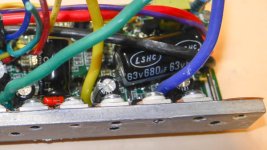Swe
100 W
Hi,
I have a 48V11,6Ah bottle-09 battery from BMSB:
https://bmsbattery.com/ebike-battery/684-48v116ah-bottle-09-panasonic-battery-charger-battery.html
The display is this one, and the controller is a 36V:
http://www.xofomotor.com/display.asp?id=807
How will I know how long trip I can use it? Is there some protection in the battery or can I destroy it if I use it too long?
I have not tested the bike that much but I guess my display shows 36V because I never see the battery indicator on the display show anything but full battery. Even though on the link I see now it says 24/36/48V...
Should I get a mini volt meter and sometines check the status? (Will hide it in the controller bag) And if so, on what voltage level should I stop driving?
http://www.ebay.com/itm/Mini-DC-5-120V-Voltmeter-Blue-LED-Panel-3-Digital-Display-Voltage-Meter-2-wire-/151440905015?pt=LH_DefaultDomain_0&hash=item234294d337
I have a 48V11,6Ah bottle-09 battery from BMSB:
https://bmsbattery.com/ebike-battery/684-48v116ah-bottle-09-panasonic-battery-charger-battery.html
The display is this one, and the controller is a 36V:
http://www.xofomotor.com/display.asp?id=807
How will I know how long trip I can use it? Is there some protection in the battery or can I destroy it if I use it too long?
I have not tested the bike that much but I guess my display shows 36V because I never see the battery indicator on the display show anything but full battery. Even though on the link I see now it says 24/36/48V...
Should I get a mini volt meter and sometines check the status? (Will hide it in the controller bag) And if so, on what voltage level should I stop driving?
http://www.ebay.com/itm/Mini-DC-5-120V-Voltmeter-Blue-LED-Panel-3-Digital-Display-Voltage-Meter-2-wire-/151440905015?pt=LH_DefaultDomain_0&hash=item234294d337


